Basil Pesto
This classic Basil Pesto recipe is incredibly simple to make, and can be tossed with pasta, spread on bread, dolloped on pizza, and so much more! This recipe has the best, most perfectly balanced proportions, and it can be made in about 5 minutes. Leftovers keep well too!
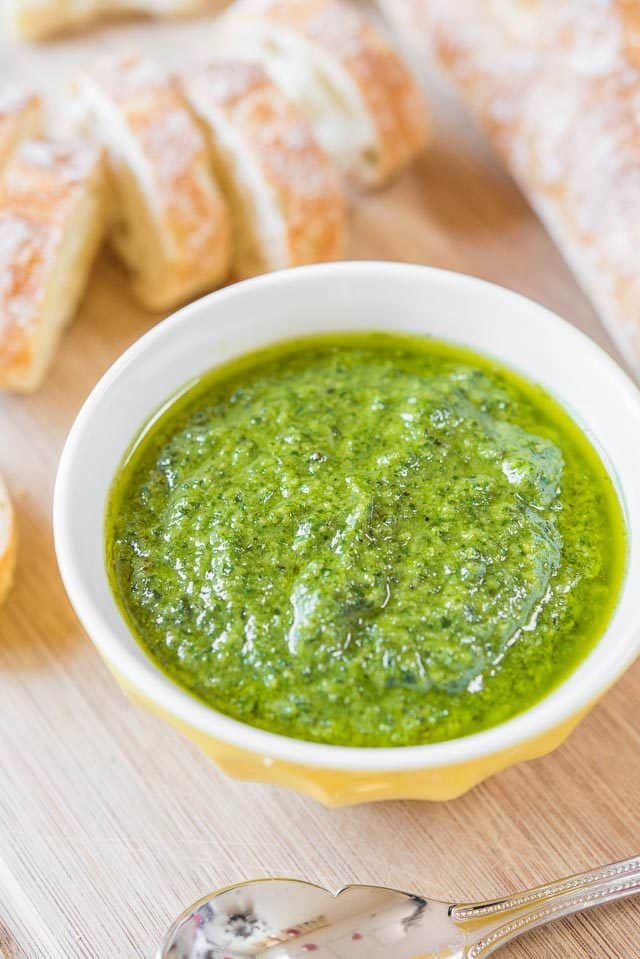
It’s hard to say if the best thing about homemade basil pesto is the fact that you can whip up a batch in 5 minutes, use it in an endless number of ways, or if the best part is just how crazy delicious it is. This is one of those foods that’s low-fuss, convenient, and richly flavorful.
The recipe I’m sharing today is for a traditional basil pesto sauce, made with the following ingredients:
- Fresh basil
- Pine nuts
- Garlic cloves
- Extra virgin olive oil
- Parmigiano reggiano cheese
And of course, seasoned with sea salt and black pepper.
Basil pesto recipes can vary quite a bit, but this version has the perfect balance of richness in flavor and texture. But know that you can certainly experiment with different types of nuts and ingredients as you get comfortable with the base recipe.
I’ve done Artichoke Pesto for these Artichoke Pesto Zucchini Rolls, I’ve done Sun-dried Tomato Pesto for Chicken Roulade, and Kale Pesto for a Mayo Free Potato Salad, to name a few. But this version is the holy grail classic that I come back to most often.
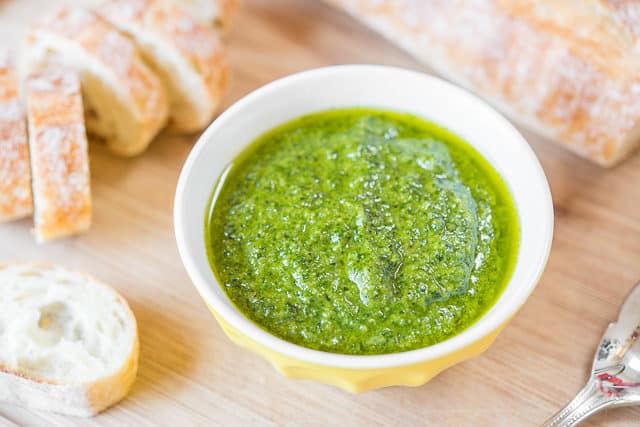
Tips for Best Results
Make sure the basil isn’t wet – After you wash your basil, make sure to dry it very thoroughly. Spin drying is generally not enough. Make sure to towel dry it too, or let it air dry further. You don’t want excess water on the basil leaves to water down your pesto sauce.
Use toasted pine nuts – If you think toasting nuts is annoying, I get what you mean. But I always do it anyway because the difference between toasted and untoasted nuts is massive. If you are not able to purchase toasted pine nuts, it shouldn’t take more than 5-10 minutes to toast your own from a raw state, and it will make your pesto so much better.
Finely grate or “zest” the parmigiano reggiano cheese – If you want to use the pre-grated parmigiano reggiano that they often have at grocery stores, it is certainly more convenient and it will work fine. But if you want truly the best results, buy an actual block piece of cheese and grate it yourself. I use my microplane zester to grate it very finely, and it cuts the parmigiano into flakes that are as light as snow. They melt so pleasingly on the tongue and disperse nicely into the pesto sauce.
Step by Step Overview:
First we’re going to need some toasted pine nuts:
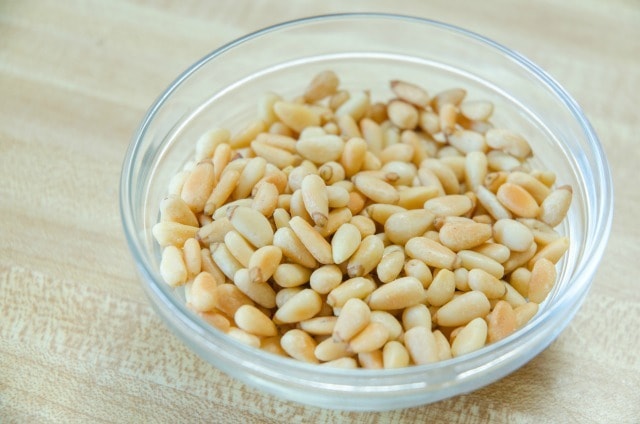
Toasting the pine nuts for the pesto is an important step, to bring out and enhance the flavor. You can toast them in a dry skillet for about 5 minutes over medium heat until golden, stirring frequently, or you can toast them on a sheet pan in a 350F oven for about 5-8 minutes, watching closely so they don’t burn.
Pine Nut Substitutions
Pine nuts are expensive, but I believe they are truly worth the expense when it comes to pesto. They are essential for a truly classic version with the pesto taste you are likely expecting. They have a really unique flavor that can’t be substituted with other nuts, and the good news is because you don’t use that much here, it’s not marginally that much more expensive than other nuts.
However, in order of my recommendation, you may also try walnuts, almonds, macadamia nuts, pistachios, pumpkin seeds, sunflower seeds, or pecans as substitutions, if you must. The flavor will vary pretty significantly.
Add the toasted pine nuts to a food processor along with some garlic, and process until smooth:
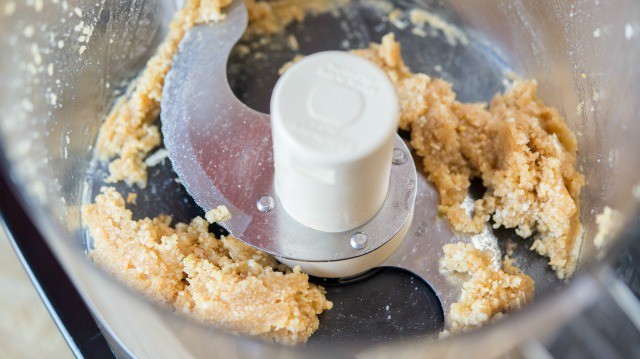
Next, add fresh Italian basil leaves, a pinch of salt and pepper, and extra virgin olive oil, and mix until it looks like this:
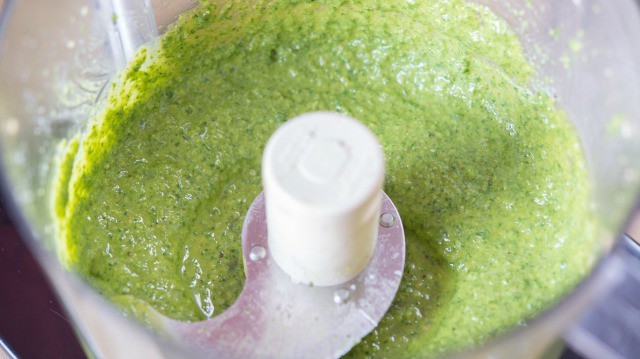
Make sure you only use the basil leaves for the pesto, and not the stems. The stems are often tough and have bitter flavors.
Also, make sure you are using an Italian Genovese basil, and not Thai basil! The flavor of the basil varies wildly depending on variety. The Italian Genovese should be the default at most groceries.
Recommended Olive Oil
Make sure to use a really flavorful and aromatic extra-virgin olive oil here, and not a “light” olive oil. A few of my favorites are California Olive Ranch, Trader Joe’s 100% Greek Kalamata EVOO, and Lucini Extra Virgin First Cold Press.
Any good quality extra virgin olive oil with fresh flavor will work though, and you can decide if you enjoy the flavor of a more fruity olive oil, or a more peppery olive oil.
At the very end, add some freshly grated parmigiano reggiano cheese:
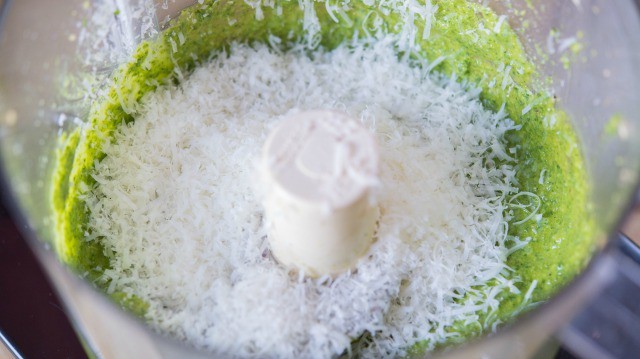
Using the authentic Italian Parmigiano Reggiano cheese is very important for a traditional flavor and pesto. Domestic parmesans are cheaper, but do not taste the same as a true 24-month aged parmigiano made from raw Italian milk, such as Mitica brand.
If you need something less expensive, try Grana Padano or Pecorino Romano, which are similarly salty and sharp.
Also, because parmesan is a hard cheese, I like to grate it very finely myself so it kind of “disappears” into the sauce, just giving its buttery flavor but not a hard texture. My grocery store sells it grated, but it’s often too coarse.
Pulse the cheese in very briefly, just until it’s mixed.
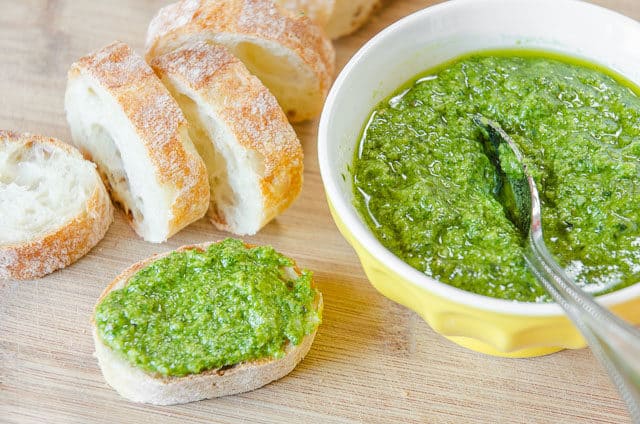
Ideas for How to Serve It
This is an incredibly versatile sauce. Stir the pesto into Caprese Pasta Salad, Rice Pilaf, or dollop onto a classic Lasagna. Pesto plays nicely with the vast majority of all pastas, rice, and starchy sides, and these are usually my favorite things for pairing.
You can also slather the pesto on slices of baguette or as a sandwich spread on an Italian Club Sandwich, main courses like Grilled Chicken Breast and Grilled Salmon, or use it as a pesto pizza sauce.
How to Keep the Pesto Green
If a bright green color is important to you, you will need to blanch the basil leaves in boiling water for 30 seconds, then immediately plunge in ice water for 30 seconds, then drain well before adding it to the pesto. This is an optional step, and just for the sake of appearance. Personally I don’t mind that the color fades a bit, and it doesn’t mean it has gone bad.
You may also add 1 tablespoon of lemon juice to the mix, however this is not a traditional flavor, so I prefer not to add it.
Recipe Tips and FAQ
Store your leftover pesto in an airtight container, or tightly covered with plastic wrap, in the fridge for up to 5 days.
Yes, but you should only use frozen pesto in cooked applications afterward, such as stirred into pasta sauces. The basil will brown a bit in the freezer and it won’t taste quite the same. Store in an airtight container for up to 2 months. Or, you can keep portions in an ice cube tray for easy melting.
Sort of. For a truly classic basil pesto, you need to use pine nuts for the proper flavor. However, you may substitute other nuts like walnuts, almonds, or pumpkin seeds for less expensive options, but the flavor will be different.
Sometimes a mix of parsley and basil is nice. This isn’t traditional, but you can also greens in place of the basil, like kale pesto for my kale pesto potato salad.
I recommend sticking in the same profile as a parmigiano reggiano, something that’s salty and a bit nutty. Decent substitutions are Grana padano and Pecorino Romano for a more tangy flavor.
The full recipe is below, and here’s a video if you’d like more guidance. Enjoy!
Did you enjoy the recipe? Please leave a 5-star rating in the recipe card below and/or a review in the comments section further down the page. Or, follow me on Facebook, Instagram or Pinterest!
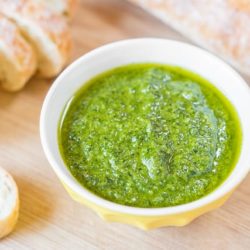
Basil Pesto
Ingredients
For the Basil Pesto:
- 3 cloves garlic peeled
- 1/2 cup toasted pinenuts *
- 2 oz fresh basil leaves
- 1/4 tsp salt or to taste
- 1/8 tsp freshly ground black pepper or to taste
- 1/2 cup extra virgin olive oil
- 1/2 cup freshly grated parmigiano reggiano cheese
Ideas for Using the Pesto (optional)
Instructions
- Place the peeled garlic cloves and toasted pinenuts in a food processor, and process for about 30 seconds until it’s well pureed and almost pastey.
- Add the basil leaves to the food processor, along with the salt and pepper, and pulse it until the basil is chopped up.
- With the food processor running, pour in the olive oil, and once it’s incorporated, stop the food processor.
- Add the parmesan cheese, and pulse it in a couple of times until incorporated.
- Do a final taste of the pesto and decide if it might need more salt or pepper. Now it’s ready to be used and enjoyed!
Notes
Nutrition
Nutrition is estimated using a food database and is only intended to be used as a guideline for informational purposes.

20 Comments on “Basil Pesto”
Your recipe is quite close to the one I use, which is 60gms home grown basil, 60gms walnuts, 60gms grated (by my local Italian store) reggiano parmigiano cheese, 30gms finely grated garlic cloves (I’m a garlic lover!) and about 160ml of
Greek Kalamata Koroneiki extra virgin olive oil from a single estate. Left tightly covered in the fridge for 24 hours to blend flavors then frozen separately in an ice cube tray with larger than normal cubes producing six 60-64 gram servings. Each is then tightly wrapped in Glad wrap and then 9 portions fit nicely inside a medium freezer bag. I make – and use it once a week – throughout the summer and can freeze enough by the end of September to have enough to last me until I start again next June. They actually freeze well if properly stored without getting freezer burn or losing perceptible flavor. I just finished my last one from Sept 23/22 and it was delicious! Of course I’ve already started freezing more to get me through the summer and then next year. 🙂
My use for it is serving it tossed with rotini pasta which itself is tossed with buttered and seasoned microwaved frozen mixed vegetables. That delicious mix fills up about half a dinner plate. Served with something like seasoned fish fillets covered with chopped onions and tomatoes and baked at 400F for 20 minutes or so it’s a dish I enjoy almost weekly! 🙂 I do sometimes serve it with lamb chops, just not as often.
Very similar recipe that I use except I have been substituting dry roasted cashews for the pine nuts and 1/4 cup of nuts. Both nut choices are good. Delicious.
What is the serving size for the nutrition info?
How much is 2 oz. of basil? We grow our own and I don’t have a scale.
Ah, at the store they sell basil in 2 oz package units so that’s why I shared that, but makes sense. I’d estimate about 2 cups lightly packed.
Just made your basil pesto with fresh leaves right from my garden. Worked perfectly, but I wanted to share a slight variation. I used walnut oil purchased for another recipe. It kicks up the nutty flavor a notch, and tastes wonderful! I like the photos to show what it’s supposed to look at each step. Thanks! Sharon?
Hi Sharon, that sounds fantastic. Thanks for sharing!
I love this on pasta and pizza. So easy to make- delicious!
This pesto is exactly how I like it! Pure, classic ingredients. Next year, I hope to have a huge basil crop so I can fill my freezer!
Soo good. I did it a little bit keto approved with pecans instead of pine nuts. Delicious!
That’s awesome, glad you enjoyed!
Thank you for listing the basil by weight. Many recipes I have read call for 2 cups of basil, but for me, the correct weight helps with “loose” ingredients like herbs and grated cheese. A kitchen scale is essential and not expensive.
Hi Bea, I’m so glad! If I had my way, I wish most things in the cooking world were by weight. Weighing things is so much easier! I will be sure to include it more. Thanks!
I want to put this on everything!
Love it 🙂
This is a must-make!
Looks so good and easy to make
Happy New Years Joanne! This classic pesto makes me want to dip my bread into the computer screen. Take Care, BAM
Great recipe!
Thank you for the recipe, especially now that my daughter has given me a food processor! I’m likely to use walnuts because pine nuts are so expensive. (I grew up in pine forests and we kids used to forage for cones with seeds while we played. Then they were free.) Can pesto be frozen?
It definitely can be! In fact, I’ve seen a few ‘life hack’ posts about freezing it in ice cube trays so you have individual portions that can be thawed at any time.